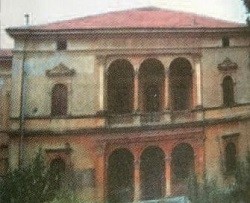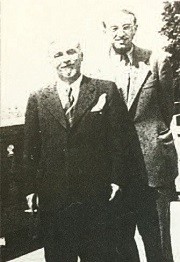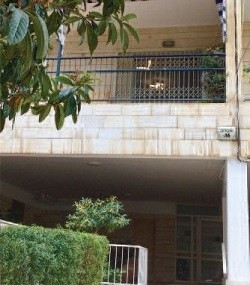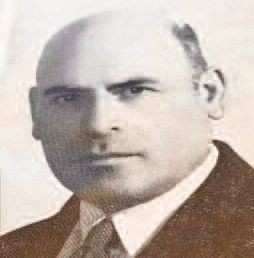Lost Story of Jewish Rescue in Italy
From Hitler's rise to power in 1933 until the early 1940's, Italy was one of the few countries that accepted both officially and through legal loopholes thousands of foreign born Jews fleeing persecution in their countries. The survival of these refugees, the majority of whom were interned in camps or sent to forced residency in small towns, would have been unimaginable without the help of Italian Jewish relief organizations.
Following the Racial Laws of 1938, Mussolini's government disbanded the Committee for the relief of Jews in Italy (COMASEBIT) established in Milan consequent to the arrival of the first wave of refugees from Austria, Germany, and Czechoslovakia. In late 1939, as Jewish refugees continued arriving, the Union of Italian Jewish Communities set up the Delegation for the Assistance of Jewish Emigrants (Delegazione Assistenza Emigranti Ebrei), known affectionately by its acronym DELASEM. The headquarters were moved from Milan to Genoa as this was the hub of activity, under the directorship of Lelio Vittorio Valobra. Funds came mainly through Paris from international Jewish institutions such as the American Jewish Joint Distribution Committee and the Hebrew Immigrant Aid Society, as well as from the Italian Jewish Communities.
Many years ago, while I was living, working and studying in New York City my graduate work was in "Italian Jewry during the Shoah"; I traveled to Jerusalem to attend a month-long seminar at the International School for Holocaust Studies at Yad Vashem.
My research focused on DELASEM (Delegazione Assistenza Emigranti Ebrei) Assistance Organization for Jewish refugees, the untold story ofthe Italian Jewish assistance organization for refuges in Italy during the Fascist years from 1939-1945.
Sometimes in life coincidence plays a significant role in the outcome of an endeavor. At Yad Vashem, Professor Sergio Della Pergola of Hebrew University was lecturing on Jewish demography, illustrating population shifts before and after the Shoah. After class I approached Professor Della Pergola explaining my dilemma: my research project "DELASEM" had hit an impasse; I needed advice to continue my work. His eyes lit up, smiling he said: "Hurray-run, we have here in Jerusalem, Bernardo Grosser, Co-Director of DELASEM and the last surviving member of the organization."
I had a return flight to New York the following week. I dialed Grosser. He welcomed my call warmly and set a time for our first meeting. This led to several years of transatlantic flights between New York and Israel to interview Grosser and listen and record the then untold story of an extraordinary organization and it equally remarkable leaders.
When I first arrived at his door holding a bunch of summer flowers, I was greeted by a charming gentleman. He was no longer young at 87 years. He lived on the lovely tree lined Rehov Sololov in the Rehavia area of Jerusalem with his wife of 48 years. Yet in his voice and manner you could still see in him the thirty-one-year-old refugee, tall, lean, with a warm smile, quick to laugh, who fled Germany and France, arriving in Italy in mid- August 1938, one suitcase in hand and no place to go.
Much of Berl Grosser's early life was similar to the lives of many eastern and central European Jews born in the late 19th and early 20th century, moving from town to town searching to settle in an area relatively free of hostility.
He was born in 1906 in a small town, Kamioniki Wieliki, in the then Austro-Hungarian Empire, now Poland. In 1910, the family emigrated to Germany and settled in the city of Zwickau. Grosser completed school and in 1925, aged 19; he opened a firm for the production and sale of decorations for woman's handwork.
With Hitler's rise to power in 1933 and escalating anti-Semitism, Grosser left Germany in 1936 for France, hoping the anti-Jewish wave engulfing Germany would not reach France. For a short period, he worked as a salesman for the well-known Paris department store Galleries Lafayette.
As a Polish citizen, he was not protected from the recent anti-Jewish legislation in France. He was forced to leave Paris in 1938 due to the impossibility of extending his work visa. Having heard that treatment of Jewish refugees in Italy was more lenient, within a few weeks he arrived in Milan, mid-August 1938. Oddly, Grosser received a visa even though the Italian Racial Laws had just been implemented. One particularly harsh clause stipulated that within 6 months of the date of the decree, Sept 1, 1938, all Jewish refugees would be expelled to their countries of origin. Berl Grosser, alone, with little money to spare and without knowledge of Italian, fell into this category.
Grosser was resourceful, determined, fearless, with a natural aptitude for languages. He spoke Yiddish, German, French and English fluently. Within three months he mastered enough Italian to look for work. His path led him to the Milanese organization for assistance to Jewish refugees that was the predecessor of DELASEM, of which he became an integral part.The paradigmatic refugee became a rescuer to his people.
Most of the story of DELASEM that follows stems from my over five years of interviews with Bernardo Grosser-1993-1998 and with material shared with me by his son Donato Grosser. Grosser, meticulous with facts, worked in his study where the shelves were filled with books, notes, documents and photographs. Sitting across from him, I listened in awe as he began the lost story of DELASEM, whose archives had been destroyed during the bombings of Genoa.
The person most responsible for the creation of DELASEM was Dante Almansi, a beloved figure to Italian Jews andthose refugees who found temporary asylum in Italy during the war.Having served the Italian government in high positions for 38 years he was well connected. When he was elected President of the Union of Italian Jewish Communities in November 1939, (Parma 1877-1947) he understood the enormous tasks confronting the Community: the most urgent was the precarious situation of foreign born Jews and emigrants imperiled by the Expulsion Decree of September 1938. .Almansi's first act as newly appointed President was to obtain permission, to set up a national organization for assistance to refugees threatened with deportation.
Lelio Vittorio Valobra, untiring Genoese lawyer, Vice President of the Union, was named National Director of DELASEM. Genoa was chosen as headquarters for its proximity to France, which in 1939 was still considered safe,as a port city it had become the hub of refugee activity, and conveniently it was Valobra's home city where as a lawyer he too was well connected.
Work began officially on December 1, 1939. The staff was recruited from the preexisting office in Milan that had assisted emigrants leaving the country and where Grosser found employment shortly after arrival. Enrico Luzzatto was appointed Director due to his knowledge of languages, particularly Serbo- Croatian; Berl, now Bernardo Grosserwas named co-Director, assigned to all aspects of emigration. Luzzatto and Grosser worked in perfect harmony 16-18 hours daily at a frenzied pace to expedite emigration abroad for as many Jews as possible. DELASEM opened branch offices in twenty-one Italian cities and in Italian occupied territory.
In the six months preceding Italian entry into the war in June 1940, DELASEM focused on emigration. It expedited the transfer of more than 2,000 Jews to safety. Those refugees with valid visas, reached Palestine, North and South America and Shanghai. Simultaneously, Luzzatto engineered refugee embarkations from the Ligurian coast of Italy to southern France. When Luzzatto was arrested for refugee smuggling, Grosser took over the operation The French opposed legal immigration, therefore DELASEM rented boats from an Italian fishing company that clandestinely ferried the refugees at night to Nice in Southern France. After a brief stay they continued to safety in Spain or Portugal. The last transport, arranged in early May 1940, was discovered by the French police. On arrival all involved were arrested. Grosser waiting on the Ligurian coast narrowly escaped arrest. In this pre- war period, estimates record that DELASEM, assisted 9,000 refugees; funds were collected from local Italian Jews and international organizations.
With the declaration of war by Italy on June 10, 1940, all foreign enemy nationals, which included Jews, were arrested, and sent to internment camps or remote villages under police surveillance. DELASEM's work increased with the internment policy. Adding to its original task, the organization assumed responsibility for the welfare of the interned Jews.
The largest camp, Ferramonti-Tarsia in a malaria infested area of Calabria, held 2,000 people of whom 1,500 were Jews. DELASEM delegates were assigned to each camp;they assessed the daily needs of the refugees. Rabbi Ricardo Pacifici, a prominent member of the Genoese delegation visited to offer material goods as well as spiritual assistance.With a small subsidy from the Italian government and DELASEM funds, the internees survived the war.
Italy and her Allies invaded Yugoslavia on April 6, 1941. After 11 days, Yugoslavia capitulated and was dismembered.The Germans occupied Serbia; the Italians took part of the Dalmatian coast. In Croatia a nominally independent government was established under the Ustasha, but immediately Croatia divided into a German and Italian military occupation zone.
The changed political situation dramatically shifted DELASEM's work from assistance to direct rescue. The Ustasha unleashed a reign of terror against Jews and Serbs in the German zone. In reaction to these massacres, Italian soldiers in the southern zone, where approximately 5,000 of 30,000 Croatian Jews lived, began a spontaneous policy of thwarting Ustasha brutality and protecting Jews.Streams of refugees fled to the Italian zone. Valobra, notified of the imminent tragedy, raced against time to save as many Jews as possible.
Within a few weeks, Almansi, obtained a permit from the Ministry of the Interior, for Valobra to travel to the Yugoslavian territories controlled by the Italian army to extend DELASEM activities. Valobra, met with Italian Army generals asking for the transfer to Italy of the Jews in the Italian zone. Several intense weeks of activity between DELASEM delegates in Croatia, Valobra and Luzzatto, and officials in Rome resulted successfully in the organization of transports to be ferried across the Adriatic to Italy, starting in the summer of 1941 and continuing through the early months of 1942. On arrival they were settled in villages in northern Italy or sent to Ferramonti where they received material assistance and a subsidy from DELASEM.
According to the narrative of Iso Doron, a 21-year-old Yugoslav soldier in 1941, he and his family succeeded in reaching the Dalmatian coast and were part of this rescue operation in the winter of 1941. Doron survived the war, immigrated to Israel and with Bernardo Grosser, who had also emigrated to Israel, founded an organization (GALPI) Gratitude to the Italian People) in recognition of the help given by the Italians to Croatian Jews. They collected 1,000 signatures of Yugoslav Jews saved by DELASEM and the Italians and in 1985 traveled to Italy to present the book to the President of the Republic, Sandro Pertini, who had been a partisan during the war.
In the spring of 1942,Valobra was notified about a group of 42 orphaned children who had survived Nazi deportations and managed to reach Slovenia. They took refuge in an old castle dangerously close to the German lines. Valobra traveled over dangerous terrain, reached the children and within 24 hours brought them to safety in Ljubljana, while he began arrangements to transfer them to Italy.
DELASEM delegates from the town of Modena rented an uninhabited villa, known as "Villa Emma" in the village of Nonantola, for the children, where in July, 1942, they were settled in.A second equally risky rescue operation, organized by the DELASEM delegate in Split saved thirty-three Croatian Sephardic children who joined the first group in the spring of 1943. The orphans became known as "the children of Nonantola" and were cared for by DELASEM and the local population of Modena. When the Germans invaded northern Italy, local priests and citizens hid the children until they were guided to Switzerland. All of the children survived the war, but at least two DELASEM representatives involved in the rescues died in extermination camps. This is sometimes referred to as DELASEM's finest achievement.
September 1943-Armistice and Clandestine activity
With the Italian Allied Armistice on September 8, 1943, the Nazis invaded northern Italy. The clandestine phase of DELASEM's work began. Headquarters in Genoa closed; the delegates scattered and in hiding. Valobra asked the Archbishop of Genoa, Pietro Boetto to continue DELASEM's work. Boetto charged his secretary, Don Repetto with the responsibility, as Valobra turned over to him all DELASEM funds, archives, lists of contacts and telephone numbers in northern Italy. A clandestine network was set up whereby the refugees and now also Italian Jews would be sheltered, fed, supplied with forged identity documents. In early November, Valobra reached safety in Switzerland. A few weeks later he began to reconstruct DELASEM as a section of the Swiss Committee for Jewish refugees. In this way it was still possible from time to time to send funds to Don Repetto.
Of the remaining Genoa delegates, Enrico Luzzatto, who had been instrumental in the Croatian rescue, was captured by the Germans and forced to work as an interpreter.After liberation he was unjustly accused of collaboration but through the help of Valobra and Grosser his name was cleared.
Rabbi Ricardo Pacifici, who refused to go into hiding was caught in a raid in November, 1943 and deported to Auschwitz where he was gassed on arrival, December 12, 1943.
Bernardo Grosser fled Genoa and hid for a short time in the mountain village of Teriasca above the Italian Riviera. The Germans learned of his whereabouts and he found refuge in Milan with a man who risked his life to hide him. Eventually, after a failed attempt to reach Switzerland he arrived on December 30, 1943. After several weeks in the internment camps, Valobra learned Grosser had safely arrived and requested he join with the Swiss Assistance Committee to continue helping the refugees.
Unlike Rome that was liberated in June, 1944, Genoa waited another ten long months for liberation. Throughout 1944 and early 1945 Valobra and Grosser with assistants, continued working on behalf of the refugees. All agreed that helping the children was priority; most were lodged with Swiss families and in danger of forgetting their Jewish identities. At the end of 1944 a school was set up for Jewish children at Weggis near Lucerne. Grosser taught the children songs, held conversations on Jewish topics, a rabbi was sent to assist with services. It was here that Grosser met his future wife, Vittoria Brunner, a refugee who had escaped with her family from Trieste where she was born. In May 1945, Grosser was appointed director of the school where he remained until August 1945 when he was repatriated to Italy.
Genoa was prostrate from continuous bombings, starvation, and harsh restrictions imposed by the occupation. Don Repetto, hunted by the Gestapo, went into hiding; Don Carlo Salvi carried on DELASEM's work. Several other clergymen in northern cities were arrested. DELASEM was torn to pieces; stripped of the capacity to begin any new projects. The Communities had lost many leaders and were devastated by the deportations. Despite the destruction, the Genoese Archdiocese continued it work. It is to the credit of the people of Genoa and the Archdiocese that they did not abandon the responsibility with which they had been entrusted by Valobra in September, 1943. The Cardinal died in 1946, Don Repetto and Don Salviare honored at Yad Vashem as "Righteous among the Nations".
Rome September 1943-June 1944
From the outset of the occupation,it was impossible for Genoa to maintain contact with Rome DELASEM. A separate network developed in the Capital where thousands of refugees converged after the armistice, trying to escape the German occupation. Added to these numbers were hundreds liberated from the internment camps in the south, seeking the imagined safety of Rome, unaware of the jeopardy they had placed themselves in.
The head of Rome DELASEM was Settimio Sorani. He and President Almansi continued to work during the nine months of German occupation, with invaluable assistance from French Capuchin monk, Padre Maria Benedetto and a group of assistants.
When DELASEM offices closed officially on October 16, 1943, day of the great round up, the group transferred to the Capuchin monastery.Padre Benedetto become DELASEM's "unofficial leader". Sorani, hunted by the Gestapo, changed identities several times and maintained continuous contact with the group.
All of the Jews had to be hidden,fed and legalized. Housing was solved by lodging them in small hotels, pensions, private homes and more than 100 religious institutions, as well as orphanages and hospitals.
Food was scarce, severely rationed. Without an official residence permit one could not obtain rations and would starve. Padre Benedetto, like his counterpart in Genoa, went into the business of making false documents. DELASEM printed its' own identity cards and necessary documents to legalize the refugees. The committee created a name for itself: Comitato Assistenza Profughi- C.A.P., printed letterheads and signed by C.A.P. President, Maria Benedetto.
By April 1944, the Allies were close-bybut never seemed to arrive. Padre Benedetto was wanted by the Gestapo and like Don Repetto in Genoa, would have been forced into hiding, had the occupation continued much longer. Fortunately, June 4, 1944 arrived. At liberation more than 4,000 Jews were hidden across Rome.
Liberation
Liberation did not terminate the tasks of DELASEM. The nucleus of the Rome group continued working in cooperation with the Allied Military Government, the American and British Red Cross and the Joint Distribution Committee.
One of the first priorities was recovery of the children hidden in convents; some of them baptized, many of them orphaned by their parents' deportation. Since there were no lists, locating them was difficult. DELASEM searched patiently, located all the children and rented a house for them to readjust to life as Jews. The lease on the house was signed proudly by Settimio Sorani in the name of DELASEM. In all, 220 children were cared for by DELASEM in conjunction with the American Foster Parents Plan. Later most of the children were helped to immigrate to Palestine.
DELASEM compiled a list of more than 35,000 names with information, from various countries, hoping to help the refugees and deportees find relatives. In 1946, this file was given to the Central Search Office of the J.D.C that had been set up to find survivors.
Slowly, the nature of DELASEM's work changed and was absorbed almost entirely by the JDC. At the end of 1947, DELASEM offices closed with a feeling of deep pride. It is estimated that between 20,000-30,000 Jews had been saved by DELASEM with cooperation from many segments of the Italian population.
After the war the people who had worked for DELASEM went back to their everyday occupations. None of them looked for or received any honors. Valobra continued practicing law in Genoa for another 30 years. He died in 1976 at age 76. Dante Almansi who heroically led Rome DELAEM during the nine months of occupation was already ill when he assumed the Presidency of the Union. He was unfairly accused of collaboration by the Allied Military Government and in 1946 traveled to New York to visit his son, Dr. Renato Almansi who had left Italy in 1938 due to the Racial Laws. It was my honor to know Dr. Almansi who shared many of the stories of his father with me. In 1947 he returned to Italy and died shortly afterwards.
And Bernardo Grosser. I continue to see his smile as it was on the first summer day we met when he was 87 years old. Bernardo Grosser married in 1945 and returned to civilian life. In 1946 his son Donato was born and in 1951 his daughter Judith. Always having incredible management skills, he became Director of the new firm for the production of plastic materials. He became an Italian citizen in 1957 and described it as "one of the most beautiful days of my life."
Grosser retired in 1972 at age 66 and moved with his family to Jerusalem. In Jerusalem he continued to work as a free-lance consultant for a market research company. He founded the Israeli society of postal history and Kol Ha Italkim, a magazine for Jews who immigrated from Italy. He was active in Care for the Needy, a tzedakah organization operating in Rehavia. In 1985 he was invited by President Pertini to Rome with Iso Doron to present the list of 1,000 Jews from Yugoslavia saved by the Italians and DELASEM. In the late 1980's and 1990's he gave interviews to Italian journalists, researchers and scholars about the rescue of Jewish refugees in Italy. He died at age 96 in May 2003. I miss him still and hope this is a fitting tribute to him and the unique relief organization DELASEM, a story that will no longer be untold.














Comments